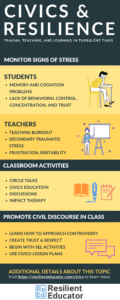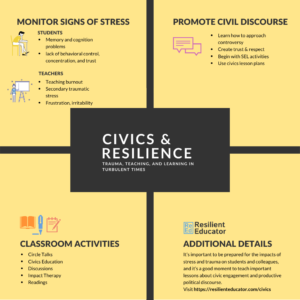
Civics & Resilience
Trauma, Teaching, and Learning In Turbulent Times
The last days of May (2020), rocked the U.S. as mass rioting and looting, alongside peaceful protests, impacted cities. Curfews were enacted, stores closed or cleared away wreckage, transportation and logistics either shut down or suffered long delays, and citizens witnessed military personnel patrolling their neighborhoods. Boarded windows and graffiti littered the landscapes of many downtown shopping areas.
Many questions still linger. What’s to blame: systemic inequalities, aggressive policing, political polarization, anarchist opportunists, inept institutions, or other reasons? Regardless of why, two things are true: everyone has their own opinions, and stress levels are very high.
This guide serves to present tactics and ideas for surviving these turbulent moments as an educator. It’s important to be prepared for the impacts that stress and trauma have on students and colleagues, but it’s also a good moment to teach important lessons about civic engagement and how to engage in productive political discourse.
Impacts of Stress
Images of violent crowds, burning cars, buildings on fire, aggressive curfew enforcement, and other brutalities filling TV and phone screens are prone to create nervousness and fear. Not just in the minds of students, but also in the minds of adults teaching them. Children can exhibit fearful emotions as anger, restlessness, and low performance. Educators may feel extra pressure and exacerbate this dilemma by responding with their own frustrations, mental breakdowns, and physical ailments. All originating from stress and trauma caused by the unrest unfolding before our eyes.
Trauma’s impacts on students extend beyond behavior and teachers can employ SEL (social-emotional learning) tactics to help students cope with stressful environments. Cognitive and memory impairments, the loss of emotional regulation, inability to trust other people, and signs of attention-deficit disorders are possible symptoms of traumatic stress. Teachers can employ several SEL tactics to help students cope with trauma-inducing situations. One classroom activity suggestion is the use of circle talks. Students form a circle, facing each other while discussing important issues. The online equivalent could be everyone activating their webcams (if permitted) and then proceed with talking to others in the virtual room. Different circles that could be formed for various purposes including: Community Discussions, Restorative Circles, and Family Groups (read more about classroom circles). Educators can even use simple counseling activities that encourage students to express their emotions and reinforce social-emotional learning principles. For more classroom activities that encourage healthy exhibitions of emotions, this article from Edutopia has additional ideas you can adopt.
Teachers can also find themselves affected by tumultuous events and negative behavior that students could bring to the classroom. One serious symptom to worry about is secondary traumatic stress, sometimes associated with teacher burnout. Being armed with knowledge about resiliency plus practicing regular self-care can block the detrimental impacts of stress. Educators should undertake activities that promote wellness, such as:
- Journaling
- Meditating
- Healthy eating
- Yoga
- Exercising
Other ways to build self-resilience are mentioned in our COVID-19 Toolkit and blog post about easy self-care habits anyone can start doing immediately.
- The Role of Empathy in Teaching Social-Emotional Skills
- Hyperactivity or Something Deeper? Childhood Trauma Misdiagnosed as ADHD
- This is a Student’s Brain on Trauma
- Social-Emotional Learning: The Magic of Circle Talk
- Why Anxiety in Teens is So Prevalent and What Can Be Done
- Useful Counseling Activities to Promote Social-Emotional Learning
- How Personal Trauma Can Lead to Teacher Burnout
- Resources for Teacher Wellbeing
- Recognizing the Signs of Secondary Traumatic Stress
Civics Engagement in School
News travels faster than ever! Social media is full of content broadcasting live events. YouTube and Facebook Live make it easy for anyone with a smartphone to record local happenings. A mere click can expose children to recordings of destruction, violence, and harsh opinions that could drive further outrage and inspire more turbulent behavior.
Are you a teacher (or parent) wondering how you could introduce children to practical, effective ways of engaging in civil discourse and positive political actions? So they can learn to argue about disagreements and engage in productive ways of impacting society? To show students alternative ways of expressing outrage or making changes in their local environment? These lessons can be introduced and refined in a classroom.
First, a teacher must create a climate that allows civil discourse. Rules must be set, boundaries should be established, and everyone’s opinion should be treated as valid. Before you allow heated discussions, you should read more about social-emotional learning tactics to create an aura of empathy at the beginning. For virtual environments, researching best practices to have engaging online discussions wouldn’t be a bad idea either.
How do you talk about the causes leading up to contentious events in students’ surrounding environments? For teenagers, it’s best to explore the circumstances with them. Come prepared with civics lessons plans from outside sources so that students understand the timelines leading up to an event. This can lead to classroom discussions that turn into important lessons about issues such as personal or systemic bias, importance of voting, the dangers of political polarization, and building critical thinking skills. You also might want to learn about approaching controversy when discussing politics in the classroom. For younger kids, especially those in early childhood, it’s best to teach simple topics. Some ideas include the Bill of Rights, the Constitution, why voting matters, and other important lessons about personal freedom. Website such as iCivics and Constitution Center have lesson plans tailored for early childhood kids.
If you’re interested in more resources about creating an inclusive learning environment, you explore resources related to anti-racist teaching.
- Build Critical Thinking Skills With Believing and Doubting Games
- Teaching Social Justice in Theory and Practice
- Mitigating the Trump Effect: Teaching Civil Discourse in a Time of Political Anger
- How Do We Teach Civics in Such a Polarized Political Climate?
- Bringing Social-Emotional Learning into the Classroom
- Creating Active Citizens: Ideas for Civic Engagement Lessons
- Cultivating Diversity, Inclusion, and Equity
- Pushing Past Personal Perspectives: Pluralism and Discourse in the Classroom
Student Calming Activities
- Student Activity: Reach for the Stars!
- Student Activity: The Game of Life
- Student Activity: My Superpowers
- Student Activity: My Positive Pledge
- Student Activity: Balancing My Responsibilities vs Activities
- Student Activity: Mind-Body Connector
- Student Activity: Calming Cards and Calming Catcher
- Student Activity: Taking Care of “Self”
- Student Activity: Be a Journalist
Teacher Calming Activities
- For Teachers: One Step At A Time
- For Teachers: How to Stay Motivated During Tough Times
- For Teachers: Embrace Life’s Change With Resiliency
- For Teachers: I Know It’s Hard … but Stay Positive
- For Teachers: Maintaining Balance in Time of Uncertainty
- For Teachers: Building Resilience Through a Strong Mind-Body Connection
- For Teachers: Building Resilience Starts with Self-Care
- For Teachers: Staying Calm Amidst Chaos
- For Teachers: Practicing Mindful News Literacy
Civic Readings
Here’s our handpicked, curated selection of book titles (aff. links) that provide deep insights about acceptance, social issues, and culture clash currently gripping the nation. Check out our list of suggestions for additional reading materials. Feel free to share the list with your fellow teachers, students, parents, and anyone else who may benefit from these great readings.















Share
You can share this page’s URL (https://resilienteducator.com/civics/) anywhere and can also use these images to provide summarized points on this page.


